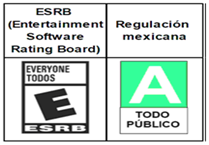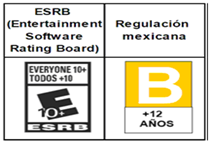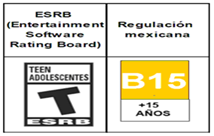General purpose
After several attempts to classify the content of video games in Mexico, the Ministry of Interior (SEGOB) on November 27, 2020, published the General Guidelines of the Mexican System of Classification Equivalencies for Video Game Content. It is more likely than not that the Mexican government borrowed a page from the Entertainment Software Rating Board (ESRB) classification system applied in United States. Moreover, the guidelines set the content specifications for classification purposes, specifying the content and interactive elements of any video game, which are included as warnings for the audience and required to be displayed by distributors, marketers or lessors of sold, leased or promoted physical and digital video games in Mexico.
Main takeaways:
- The guidelines will come into force on 26 May 2021, after which its contents will be enforceable. Noncompliance could result in ex-officio investigation and potential penalties.
- According to SEGOB’s parameters, the purpose of the guidelines is to prevent minors from having access to content that could be harmful or affect them. The obligation included within the guidelines are regulatory requirements that should be complied for conducting video game business in Mexico, either physical or digital copies.
- Under the guidelines, the distributor, marketer or lessors of a physical or digital game have the obligation to include the display of the appropriate classification equivalence for the audience. This obligation is independent from the ESRB classification and its display. To comply, the video game must display reference to the Mexican classification; otherwise, it could be deemed non-compliant. Please find the classification and display requirements outlined below.
- Developers and publishers will be in charge of submitting their video games for rating purposes before the ESRB. Distributors, marketers or lessors (including digital video game platforms) of physical and digital video games sold, leased or promoted in Mexico will be in charge of displaying the appropriate classification equivalence in accordance with the guidelines.
- If a developer or publisher is not satisfied with the classification assigned by the ESRB to its video game, they will have to revise the content of their video games and resubmit it to the ESRB, at which point the rating process stars again in accordance with the ESRB rating process.
- The General Directorate of Radio, Television and Cinematography of the SEGOB is in charge of carrying out investigations and enforcing the guidelines. Given its novelty, we should anticipate an unpredictable start but with a certain degree of aggressiveness from the authority, especially as the guidelines intend to protect children.
- Failure to comply with the guidelines may be sanctioned with fines ranging between MXN 369,600 and MXN 3,696,600 (approximately between USD 18,500 and USD 185,000). Fines may be doubled for repeated infringement.
Video games content classification
Video games content in Mexico is categorized as follows:
• “A”: For everyone

• “B”: Everyone over the age of 12

• “B15”: Everyone over the age of 15

• “C”: Content not suitable for people under the age of 18

• “D”: Exclusively for adults (extreme content)

* Video games classified as C and D may only be sold to people over the age of 18 upon the presentation of an official ID.
Graphic specifications for warnings, content descriptors and interactive elements
Graphic specifications of the stamp
• Measurements of the stamp on the front cover:
| Box size | Sort stamp size |
| Small = up to 76.2 cm2 | Not less than 1.2 cm wide x 1.8 high |
| Medium = more than 76.2 cm2 and up to 106.68 cm2 | Not less than 1.4 cm wide x 2.1 high |
| Big = more than 106.68 cm2 | At least 11% of the box size |
- The font to be used for the classification is Arial.
- Font size for classification and warning notes cannot be less than 7 points (Arial) for small boxes and 10 points for the medium and big boxes.
Stamp measurements on reverse face
- If the video game is assigned one or more content descriptors or interactive elements, the descriptive stamp must be located on the back cover of the product.
| Box size | Sort stamp size |
| Small = up to 76.2 cm2 | Not less than 1.6 cm high and the width must include[ELES1] each content descriptor on a separate line with Arial font of at least 7 points |
| Medium = more than 76.2 cm2 and up to 106.68 cm2 | Not less than 1.6 cm high and the width must include each content descriptor on a separate line with Arial font of at least 7 points |
| Big = more than 106.68 cm2 | Not less than 8% of the height of the box |
- The descriptive stamp must be located, printed or attached at the bottom of the back cover or reverse, as follows:

- The font for the classification letter is Arial, and the font size may not be less than 10 points but may be larger than the size of this letter and the icon to be proportional to the size of the box.
- The font size of content descriptors cannot be less than 7 points, but may be larger to be proportional to the number and extent, considering all the descriptors in the game. Each content descriptor must be pointed to on a separate line to facilitate reading.
- The font size of interactive elements cannot be less than 8 points, but may be larger to be proportional to the number and extent, considering all the descriptors in the game. Each interactive element should be pointed to a separate line or separated by a forward slash to facilitate reading.
Content descriptors
- Blood animation: Discolored or unrealistic representations of blood
- Real bets: Ability of player to bet, even place bets on genuine money or currencies
- Simulated bets: Ability of player to bet without placing bets on real money or currencies
- Sexual content: Non-explicit representations of sexual behavior, with possible partial nudity
- Strong sexual content: Explicit or frequent representations of sexual behavior, perhaps with nudity
- Bloodshed: Representations of blood or mutilation of body parts
- Nudity: Graphic or prolonged representations of nudity
- Partial nudity: Brief or moderate representations of nudity
- Adult humor: Performances or dialogue containing adult humor, including sexual allusions
- Vulgar humor: Representations or dialogue involving vulgar jokes, including eschatological humor
- Language: Moderate use of obscene language
- Strong language: Explicit or frequent use of obscene language
- Song lyrics: Moderate references to obscene language, sexuality, violence, alcohol or drug use in music content
- Strong song lyrics: Explicit or frequent allusions to obscene language, sex, violence or use of alcohol or drugs in music content
- Drug reference: Drug reference or images
- Reference to alcohol: Reference to and images of alcoholic beverages
- Tobacco reference: reference or images of tobacco products
- Blood: Blood representations
- Violent references: Allusions to violent acts
- Comic traverses Representations or dialogues involving antics or suggestive humor
- Insinuating topics: Moderate references or provocative materials
- Sexual issues: Allusions to sex or sexuality
- Alcohol use: Consumption of alcohol or alcoholic beverages
- Drug use: Drug use
- Tobacco use: Consumption or use of tobacco products
- Violence: Scenes that include aggressive conflict; may contain bloodless dismemberment
- Cartoon violence: Violent actions that include cartoon situations and characters; can include violence in which a character comes out unscathed after the action took place
- Fantasy violence: Violent actions of a fantastic nature that include human and non-human characters in situations that may easily be distinguished from real-life situations
- Intense violence: Graphic and realistic-looking representations of physical conflicts; may include excessive or realistic blood, bloodshed, weapons, and depictions of human injury and death
- Sexual violence: Depictions of rape or other violent sexual acts
Interactive elements
- In-game purchases (includes random items): Contains in-game offers to purchase digital or promotional products with real-world currencies (or virtual currencies or other in-game currency types that can be purchased in real currencies) in cases where the player does not know, prior to purchase, the digital or promotional products they will receive (reward boxes, loot boxes)
- User interaction: Indicates possible exposure to uncensored, uncensored user-generated content, including user-to-user communications and shared media via media and social media
- Shared location: Includes the ability to display the user’s location to other users of the app
- Unlimited internet: Provides unrestricted access to the internet (browser, search engine)



